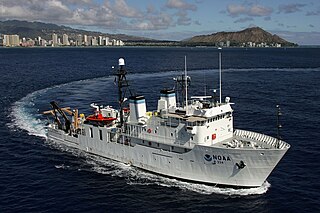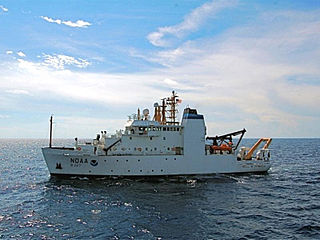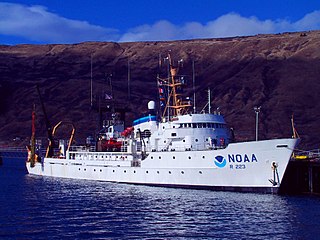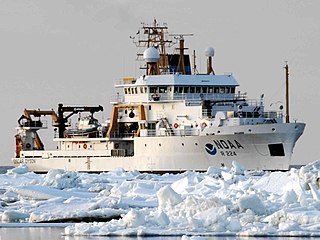
The Sikorsky Cypher and Cypher II are types of unmanned aerial vehicles developed by Sikorsky Aircraft. They are vertical takeoff and landing aircraft which use two opposing rotors enclosed in a circular shroud for propulsion.

The Naval Aircraft Factory SBN was a United States three-seat mid-wing monoplane scout bomber/torpedo aircraft designed by the Brewster Aeronautical Corporation and built under license by the Naval Aircraft Factory in Philadelphia, Pennsylvania. The landing gear was similar to that on the Brewster F2A Buffalo fighter aircraft. The SBN had non-folding wings with perforated flaps.

The Office of Marine and Aviation Operations (OMAO) is a division of the National Oceanic and Atmospheric Administration (NOAA) which operates a wide variety of specialized ships and aircraft to carry out the environmental and scientific missions of NOAA.

NOAAS Ronald H. Brown is a Thomas G. Thompson-class blue-water research vessel of the U.S. National Oceanic and Atmospheric Administration, she is NOAA's only Global-Class research ship.

USNS Vindicator (T-AGOS-3) was a United States Navy Stalwart-class modified tactical auxiliary general ocean surveillance ship that was in service from 1984 to 1993. Vindicator then served in the United States Coast Guard from 1994 to 2001 as the medium endurance cutter USCGC Vindicator (WMEC-3). From 2004 to 2020, she was in commission in the National Oceanic and Atmospheric Administration (NOAA) fleet as the oceanographic research ship NOAAS Hi'ialakai.

USNS Titan (T-AGOS-15) was a Stalwart-class modified tactical auxiliary general ocean surveillance ship in service in the United States Navy from 1989 to 1993. From 1996 to 2014, she was in commission in the National Oceanic and Atmospheric Administration (NOAA) fleet as the oceanographic research ship NOAAS Ka'imimoana.

USNS Relentless (T-AGOS-18) was a Stalwart-class modified tactical auxiliary general ocean surveillance ship in service in the United States Navy from 1990 to 1993. Since 1998, she has been in commission in the National Oceanic and Atmospheric Administration (NOAA) fleet as the fisheries research ship NOAAS Gordon Gunter.

The first USS Patuxent was a fleet tug in commission in the United States Navy from 1909 to 1924. She served the United States Atlantic Fleet and saw service in World War I. After the end of her Navy career, she was in commission in the United States Bureau of Fisheries from 1926 to 1932 as the fisheries research ship USFS Albatross II.

Cross Seamount is a seamount far southwest of the Hawaii archipelago, about equidistant from the cities of Honolulu and Kona. It is one of the numerous seamounts surrounding Hawaii, although unrelated to the Hawaiian hotspot. It is notable for being one of the best studied of the numerous seamounts surrounding Hawaii, as it has been included in numerous biological surveys, most recently in 2007. It is also a site of offshore fishing, for its abundant tuna. The fishery management problems at Cross Seamount are typical of management problems in many fisheries, and its small size makes it a scientifically useful model for the analysis of fishery management.

NOAAS Bell M. Shimada is an American fisheries research ship in commission with the National Oceanic and Atmospheric Administration (NOAA) since 2010. She operates along the United States West Coast.

NOAAS Reuben Lasker is a National Oceanic and Atmospheric Administration (NOAA) fishery research vessel. The ship's namesake, Reuben Lasker, was a fisheries biologist who served with the Southwest Fisheries Center, National Marine Fisheries Service, and taught at the Scripps Institution of Oceanography.

NOAAS Whiting, was an American survey ship that was in commission in the National Oceanic and Atmospheric Administration (NOAA) from 1970 to 2003. Previously, she had been in commission in the United States Coast and Geodetic Survey from 1963 to 1970 as USC&GS Whiting.

NOAAS Oregon II is an American fisheries research vessel in commission in the National Oceanic and Atmospheric Administration (NOAA) fleet since 1977. Prior to her NOAA career, she was delivered to the United States Fish and Wildlife Service's Bureau of Commercial Fisheries in 1967 as US FWS Oregon II, but not commissioned. She was transferred to NOAA in 1970, but was not placed in commission until 1977.

NOAAS Miller Freeman was an American fisheries and oceanographic research vessel that was in commission in the National Oceanic and Atmospheric Administration (NOAA) fleet from 1975 to 2013. Prior to her NOAA career, she was in commission in the United States Fish and Wildlife Service's Bureau of Commercial Fisheries from 1967 to 1970 as US FWS Miller Freeman.

NOAAS Townsend Cromwell was an American fisheries research vessel that was in commission in the National Oceanic and Atmospheric Administration (NOAA) fleet from 1975 to 2002. Prior to her NOAA career, she was in the United States Fish and Wildlife Service's Bureau of Commercial Fisheries fleet from 1963 to 1975 as US FWS Townsend Cromwell.

NOAAS Chapman was an American fisheries research vessel that was in commission in the National Oceanic and Atmospheric Administration (NOAA) fleet from 1980 to 1998. After the conclusion of her NOAA career, she spent several years operating as the University of Puerto Rico marine research vessel R/V Chapman. More recently, she has become the Curaçao-based mothership for the deep-diving submarine Curasub.

NOAAS David Starr Jordan (R444)) was an American fisheries research vessel in commission in the National Oceanic and Atmospheric Administration (NOAA) from 1970 to 2010. She previously was in the United States Fish and Wildlife Service's Bureau of Commercial Fisheries fleet from 1966 to 1970 as US FWS David Starr Jordan.

NOAAS Oscar Dyson is an American fisheries and oceanographic research vessel in commission in the National Oceanic and Atmospheric Administration (NOAA) fleet since 2005.

NOAAS Pisces is an American fisheries and oceanographic research vessel in commission in the National Oceanic and Atmospheric Administration (NOAA) fleet since 2009.

Oscar Elton Sette, who preferred to be called Elton Sette, was an influential 20th-century American fisheries scientist. During a five-decade career with the United States Bureau of Fisheries, United States Fish and Wildlife Service and its Bureau of Commercial Fisheries, and the National Marine Fisheries Service, Sette pioneered the integration of fisheries science with the sciences of oceanography and meteorology to develop a complete understanding of the physical and biological characteristics of the ocean environment and the effects of those characteristics on fisheries and fluctuations in the abundance of fish. He is recognized both in the United States and internationally for many significant contributions he made to marine fisheries research and for his leadership in the maturation of fisheries science to encompass fisheries oceanography, defined as the "appraisal or exploitation of any kind of [marine] organism useful to Man" and "the study of oceanic processes affecting the abundance and availability of commercial fishes." Many fisheries scientists consider him to be the "father of modern fisheries science."





















